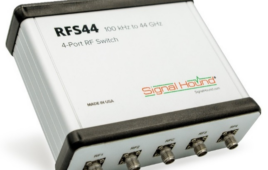Team Finds New Possibilities in Untapped Terahertz Range With Implications For a Host of Devices
 Comic book hero superpowers may be one step closer to reality after the latest technological feats made by researchers at UT Dallas. They have designed an imager chip that could turn mobile phones into devices that can see through walls, wood, plastics, paper and other objects.
Comic book hero superpowers may be one step closer to reality after the latest technological feats made by researchers at UT Dallas. They have designed an imager chip that could turn mobile phones into devices that can see through walls, wood, plastics, paper and other objects.
The team’s research linked two scientific advances. One involves tapping into an unused range in the electromagnetic spectrum. The other is a new microchip technology.
The electromagnetic spectrum characterizes wavelengths of energy. For example, radio waves for AM and FM signals, or microwaves used for cell phones or the infrared wavelength that makes night vision devices possible.
But the terahertz band of the electromagnetic spectrum, one of the wavelength ranges that falls between microwave and infrared, has not been accessible for most consumer devices.
“We’ve created approaches that open a previously untapped portion of the electromagnetic spectrum for consumer use and life-saving medical applications,” said Dr. Kenneth O, professor of electrical engineering at UT Dallas and director of the Texas Analog Center of Excellence(TxACE). “The terahertz range is full of unlimited potential that could benefit us all.”
Using the new approach, images can be created with signals operating in the terahertz (THz) range without having to use several lenses inside a device. This could reduce overall size and cost.
The second advance that makes the findings applicable for consumer devices is the technology used to create the microchip. Chips manufactured using CMOS (Complementary Metal-Oxide Semiconductor) technology form the basis of many consumer electronic devices used in daily life such as personal computers, smart phones, high definition TV and game consoles.
“CMOS is affordable and can be used to make lots of chips,” Dr. O said. “The combination of CMOS and terahertz means you could put this chip and receiver on the back of a cellphone, turning it into a device carried in your pocket that can see through objects.” Due to privacy concerns, Dr. O and his team are focused on uses in the distance range of less than four inches.
Consumer applications of such technology could range from finding studs in walls to authentication of important documents. Businesses could use it to detect counterfeit money. Manufacturing companies could apply it to process control. There are also more communication channels available in terahertz than the range currently used for wireless communication, so information could be more rapidly shared at this frequency.
Terahertz can also be used for imaging to detect cancer tumors, diagnosing disease through breath analysis, and monitoring air toxicity.
“There are all kinds of things you could be able to do that we just haven’t yet thought about,” said Dr. O, holder of the Texas Instruments Distinguished Chair.
The research was presented at the most recent International Solid-State Circuits Conference (ISSCC). The team will work next to build an entire working imaging system based on the CMOS terahertz system.
Other authors of the paper include Ruonan Han and Yaming Zhang, former students of Professor O, Youngwan Kim and Dae Yeon Kim, TxACE members, and Hisashi Sam Shichijio, research professor at TxACE.
The work was supported by the Center for Circuit & System Solutions (C2S2 Center) and conducted in the TxACE laboratory at UT Dallas, which is funded by the Semiconductor Research Corporation (SRC), the state through its Texas Emerging Technology Fund, Texas Instruments Inc., The UT System and UT Dallas.
Posted by Ron M. Seidel, Editorial Intern
April 19, 2012




